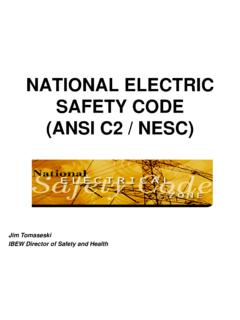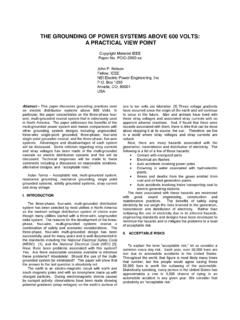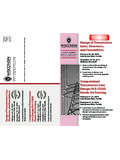Transcription of ITU-T K
1 International Telecommunication Union ITU-T STANDARDIZATION SECTOR OF ITU (05/ 2012 ) SERIES K: PROTECTION AGAINST INTERFERENCE Evaluation techniques and working procedures for compliance with exposure limits of network operator personnel to power-frequency electromagnetic fields Recommendation ITU-T Rec. ITU-T (05/ 2012 ) i Recommendation ITU-T Evaluation techniques and working procedures for compliance with exposure limits of network operator personnel to power-frequency electromagnetic fields Summary Recommendation ITU-T provides evaluation techniques and guidelines for compliance with safety limits for human exposure to electromagnetic fields (EMFs) of telecommunication network personnel ( , outside plant craft) at power frequencies (DC, 50 Hz and 60 Hz). This Recommendation does not set safety limits; it seeks to provide techniques and procedures for determining the need for any precautions at the work site.
2 This Recommendation includes an electronic attachment containing the EMFACDC program. History Edition RecommendationApproval Study Group ITU-T 2012 -05-29 5 ii Rec. ITU-T (05/ 2012 ) FOREWORD The International Telecommunication Union (ITU) is the United Nations specialized agency in the field of telecommunications, information and communication technologies (ICTs). The ITU Telecommunication Standardization Sector ( ITU-T ) is a permanent organ of ITU. ITU-T is responsible for studying technical, operating and tariff questions and issuing Recommendations on them with a view to standardizing telecommunications on a worldwide basis. The World Telecommunication Standardization Assembly (WTSA), which meets every four years, establishes the topics for study by the ITU-T study groups which, in turn, produce Recommendations on these topics. The approval of ITU-T Recommendations is covered by the procedure laid down in WTSA Resolution 1.
3 In some areas of information technology which fall within ITU-T 's purview, the necessary standards are prepared on a collaborative basis with ISO and IEC. NOTE In this Recommendation, the expression "Administration" is used for conciseness to indicate both a telecommunication administration and a recognized operating agency. Compliance with this Recommendation is voluntary. However, the Recommendation may contain certain mandatory provisions (to ensure, , interoperability or applicability) and compliance with the Recommendation is achieved when all of these mandatory provisions are met. The words "shall" or some other obligatory language such as "must" and the negative equivalents are used to express requirements. The use of such words does not suggest that compliance with the Recommendation is required of any party. INTELLECTUAL PROPERTY RIGHTS ITU draws attention to the possibility that the practice or implementation of this Recommendation may involve the use of a claimed Intellectual Property Right.
4 ITU takes no position concerning the evidence, validity or applicability of claimed Intellectual Property Rights, whether asserted by ITU members or others outside of the Recommendation development process. As of the date of approval of this Recommendation, ITU had not received notice of intellectual property, protected by patents, which may be required to implement this Recommendation. However, implementers are cautioned that this may not represent the latest information and are therefore strongly urged to consult the TSB patent database at ITU 2012 All rights reserved. No part of this publication may be reproduced, by any means whatsoever, without the prior written permission of ITU. Rec. ITU-T (05/ 2012 ) iii Table of Contents Page 1 Scope .. 1 2 1 3 Terms and definitions .. 2 4 Abbreviations and acronyms .. 2 5 General principles .. 3 Field exposure limits .. 3 Exposure zones .. 4 Sparkover.
5 5 6 Magnetic and electric field calculations .. 5 General procedure .. 5 Magnetic field .. 6 Electric field .. 7 7 Computer program .. 8 8 Examples of calculations .. 8 Simple geometries .. 8 Typical examples of power lines .. 10 9 Work procedures .. 15 Appendix I MAD values for communication workers used in North America .. 17 Appendix II Description of the program EMFACDC .. 18 20 Electronic attachment: EMFACDC program Rec. ITU-T (05/ 2012 ) 1 Recommendation ITU-T Evaluation techniques and working procedures for compliance with exposure limits of network operator personnel to power-frequency electromagnetic fields 1 Scope This Recommendation1 aims to help with compliance of telecommunication network personnel working in vicinity of medium-voltage (MV) and high-voltage (HV) power lines with safety limits for human exposure to electromagnetic fields (EMFs) at power frequencies (DC, 50 Hz and 60 Hz).
6 Also, it aims to provide practical work rules as one of the means of safeguarding network personnel that may need to work in close proximity to the MV and HV power lines. Where local or national laws, standards or guidelines on work safety or exposure limits to EMF exist and provide procedures that are at variance with this Recommendation, the pertinent local or national laws, standards or guidelines shall take precedence over the procedures provided in this Recommendation. This Recommendation does not cover exposure to electromagnetic fields at frequencies other than DC, 50 Hz and 60 Hz. This Recommendation does not cover exposure to touch currents that arise as a result of coupling of electromagnetic fields generated by the power lines to other metallic objects, including telecommunication circuits. [b- ITU-T ] aims to help with compliance of telecommunication installations and mobile handsets or other radiating devices used against the head with safety limits for human exposure to electromagnetic fields (EMFs).
7 [b- ITU-T ] covers safety issues related to people coming in contact with telecommunication circuits exposed to the induction of AC electric power or AC electrified railway lines. 2 References The following ITU-T Recommendations and other references contain provisions which, through reference in this text, constitute provisions of this Recommendation. At the time of publication, the editions indicated were valid. All Recommendations and other references are subject to revision; users of this Recommendation are therefore encouraged to investigate the possibility of applying the most recent edition of the Recommendations and other references listed below. A list of the currently valid ITU-T Recommendations is regularly published. The reference to a document within this Recommendation does not give it, as a stand-alone document, the status of a Recommendation. [IEC 61472] IEC 61472 (2004), Live working Minimum approach distances for systems in the voltage range kV to 800 kV A method of calculation.
8 < > [ICNIRP 1] ICNIRP (2010), ICNIRP Guidelines for Limiting Exposure to Time-Varying Electric, Magnetic and Electromagnetic Fields (1Hz-100 kHz), Health Physics, Vol. 99, No. 6; pp. 818-836. < > [ICNIRP 2] ICNIRP (2009), ICNIRP guidelines on limits of exposure to static magnetic fields. Health Physics, Vol. 96, No. 4; pp. 504-514. < > _____ 1 This Recommendation includes an electronic attachment containing the EMFACDC program. 2 Rec. ITU-T (05/ 2012 ) 3 Terms and definitions This Recommendation defines the terms defined in this clause. The definitions are harmonized with those used in [b- ITU-T ]. controlled/occupational exposure: Controlled/occupational exposure applies to situations where the persons are exposed as a consequence of their employment and in which those persons who are exposed have been made fully aware of the potential for exposure and can exercise control over their exposure. Occupational/controlled exposure also applies where the exposure is of transient nature as a result of incidental passage through a location where the exposure limits may be above the general population/uncontrolled limits, as long as the exposed person has been made fully aware of the potential for exposure and can exercise control over his or her exposure by leaving the area or by some other appropriate means.
9 Energized: Electrically connected to a source of potential difference or electrically charged so as to have a potential different from that of the earth. exposed: Not isolated or guarded. general public: All non-workers (see definition of workers in clause ) are defined as the general public. general population/uncontrolled exposure: General population/uncontrolled exposure applies to situations in which the general public may be exposed or in which persons who are exposed as a consequence of their employment may not be made fully aware of the potential for exposure or cannot exercise control over their exposure. minimum air insulation distance (MAID) (DU): The shortest distance between an energized electrical apparatus and/or worker's body at different potential. With a floating electrode in the gap, it is equal to or greater than the sum of the individual maximum air insulation distance.
10 This is an electrical quantity and does not include an ergonomic factor for inadvertent movement. minimum approach distance (MAD) (DA): The minimum air insulation distance plus an ergonomic distance to account for inadvertent movement. sparkover: A disruptive discharge between preset electrodes in either a gaseous or a liquid dielectric. workers: Persons employed by an employer, including trainees and apprentices but excluding domestic servants. 4 Abbreviations and acronyms This Recommendation uses the following abbreviations and acronyms: AC Alternating Current DC Direct Current EMF Electromagnetic Field MAD Minimum Approach Distance MAID Minimum Air Insulation Distance NESC National Electrical Safety Code RMS Root Mean Square Rec. ITU-T (05/ 2012 ) 3 5 General principles There are three hazards to workers working near energized power lines.






